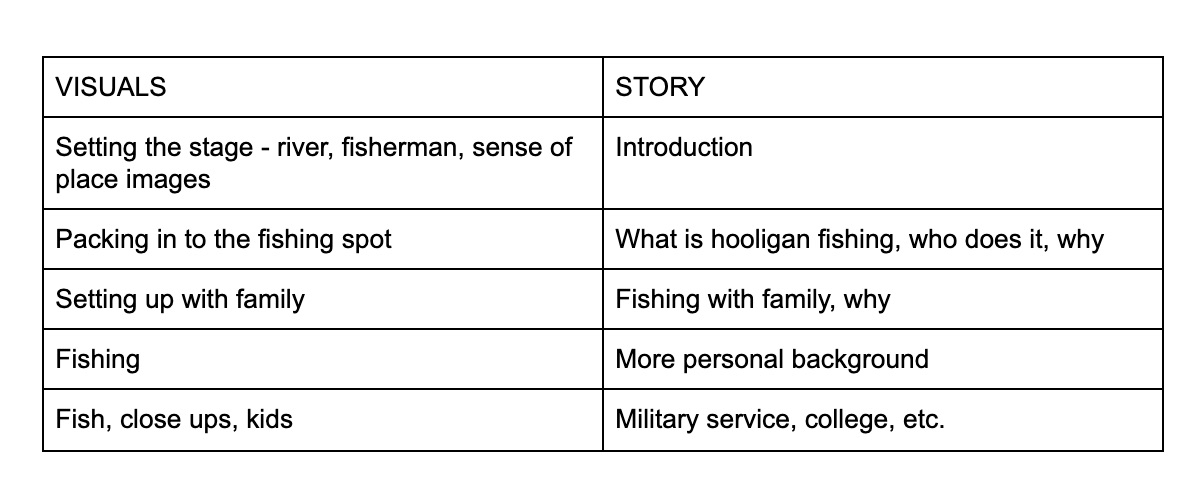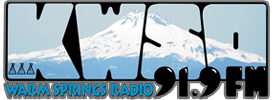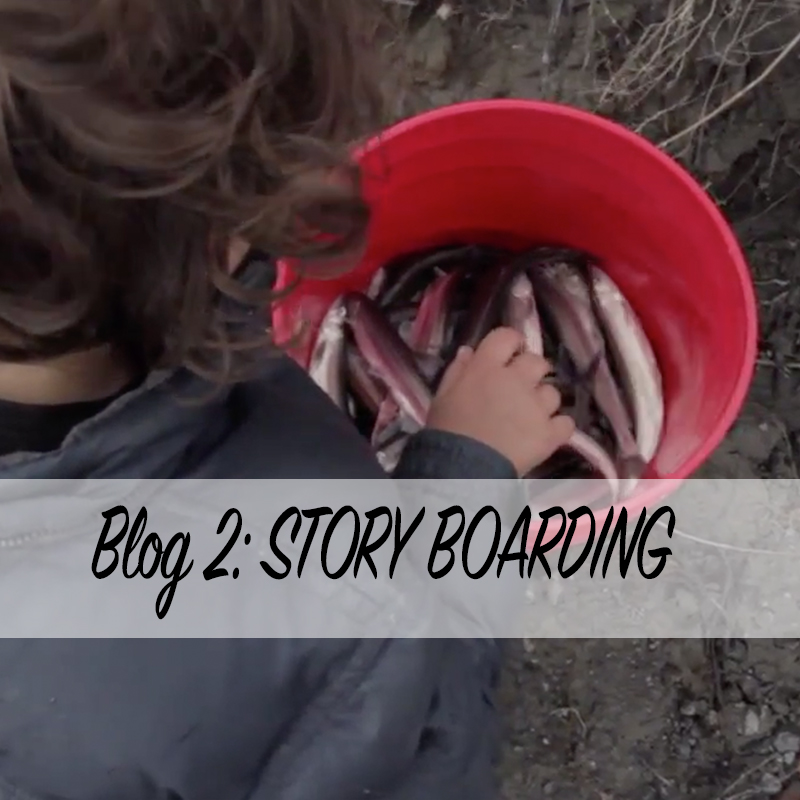Uncategorized
Video Learning Blog 2 – Story Boarding
As we learned in the previous post, there is a lot of technique you can use to brainstorm and find stories for a documentary production. The next step – something to think about before you make contact with a potential storyteller – is a simple outlining technique called story boarding.
If you haven’t taken a look at the previous post, you can find it here.
Some Background
Living in Alaska, it took me a few years to really get a handle on the seasonality of the place, and how many of the stories out there to be “found” were tied to the season and what people do out on the land during different times of year. That could mean salmon fishing, berrypicking, winter sports, yard cleanup, times to travel and times to stay home. For me, this was a major change of pace in life and also exciting and refreshing.
Every year, one of the earliest fish runs to happen in Southcentral Alaska is the hooligan, or candlefish. The fish are kind of like a smelt, and they run up a number of rivers in the area after the snow begins to melt. Having grown up in Oregon, I had never really done any type of dipnetting for fish – but, I couldn’t help but be intrigued. I knew I’d like to find a story, but I needed to find a way in.
It isn’t uncommon for the local newspaper or commercial TV news to do a short story on the hooligan run. Often these reports were limited to a fairly surface level look at it. The newspaper might only have a photo on the local news page. The TV crew may get a few short interviews, but not much more. Clearly, there were great images to be captured. You could see it was a diverse group of people after the fish. But, what I never really saw in these reports was much attention to the WHY part of the journalistic “who, what, when, where and why”. I think the short documentary is a great format to build out the question of “why?”
Here’s the video I made – more than 7 years ago:
This is a fairly simple documentary. As I’ve progressed in my career, I find it a little hard to look back at older work. I think everyone does. It’s like looking at the first weld you ever did, or the first bird house you built, or the drawings in your notebook from middle school. But, I thought this would be a good example to use to break down how I used pre-production work (the stuff we do BEFORE we shoot something) to make it a more interesting video. We’ll also talk about where I think I screwed it up. Or, one of the ways I think I did, haha!
Pre-Production & Planning & Simple Story Boarding
When I knew I wanted to do a story on the hooligan fishery, I also knew I needed to plan ahead. I could just show up at the river early in the morning, hoping to find a person fishing who wanted to spend the better part of the day with me – but, that seemed like a pretty big gamble, and a lot to ask of someone. I would also have less control over how long they would be willing to be interviewed, and likely unable to get much footage beyond fishing itself. And, it’s a relatively short run of fish that takes place about an hour’s drive away.
Having made friends with some folks that grew up in the area, I decided to put a call out on social media to see if anyone was going fishing for hooligan in the next few weeks. I got several responses – mostly tagging other people. This is fertile ground for finding a good documentary subject. If they’re a friend of a friend, chances are they’ll be open to your ideas… but not so familiar with you that the idea of making a movie with you would sound too awkward. It’s also valuable, as the filmmaker, to not know too much about the person you’re working with, and ultimately interviewing ahead of time.
I did an initial call with the fisherman, and after some explanation, he was interested in participating. I was producing this video as part of a weekly series for PBS Digital Studios, called Indie Alaska. I think the connection to PBS helped give me some credibility – but maybe not as much as having friends in common. During that initial call, I started a process that we always do when planning a documentary video like this – simple story boarding. I learned a number of things about him just through conversation: he is Alaska Native, grew up between rural and urban environments, is a veteran, has a young family, and he likes to harvest food himself for a number of personal reasons.
Immediately following the call, I began to develop a simple story board for the video. The beauty of this tool is that you don’t need to get fancy – it’s just two columns: one for the visuals – what we will see on the screen – and, another for what I think the person might be talking about when we see those visuals. This is not to say that this story will be set in stone for the eventual edit. But, it does offer you a roadmap for your shots and insurance that you’ll be able to get enough material to complete your edit.
Here’s a quick story board example for this video:

Now I won’t finish this story board completely here – I think the original is probably on a long lost legal pad – but, I want to point out how simple and easy it is to start to lay out a plan. For a short documentary of this kind, I knew that I needed to have several different “scenes” that would help keep the story moving and offer some visual variety. Knowing I planned to have a single speaker, and keep the overall length under 5 minutes – I knew I needed at least 3-4 different locations. I was able to work this out with my fisherman right there on the initial call. Yes, we’re going fishing – what else can we do together? Can I come and watch you process the fish? Can we do another activity with your family?
In this case, my different scenes are really quite simple: Arriving at the river to fish, walking to the fishing spot, setting up a small day camp, fishing, heading back after fishing, and processing the fish later on. Though this may seem like an obvious progression, it is important to think it through so that you make sure you get enough video of each of the steps to cut together into a final video. We’ll talk more about how to plan this even further when we talk about “shot lists” and how to create a visual plan to ensure you end up with enough variety, as well as the types of shots you should get.
When you set about filling in some of the story elements alongside your scenes, it’s not necessary to put words in their mouth or anticipate what you think they’ll say. What you’re really doing here is just organizing themes for your interview topics. You may find after your interview that whole other things came out, that may even be better than your initial ideas. You’ll find with time that what you didn’t expect is the best stuff that comes out of an interview. But, hoping for unexpected gold is not an excuse for poor planning.
Where Did I Screw Up?
If I were making this documentary today, I would absolutely push myself to capture more scenes – especially with an eye for variety. Some ideas for that might be: cooking together as a family; having a meal of fish at home; playing with the kids in the home environment; the fisherman at his regular 9-5 job; interacting more with mom/grandma or spouse; fisherman doing another activity in the urban environment like shopping.
There are a lot of pieces to this story that I don’t have visuals for – the fisherman talks about learning about his heritage, his time serving in the marines, the difference between gathering foods and going to the grocery store. If I had done a better job of initial planning on this shoot, I could have planned to include some scenes that would better fit those storylines.
As I said, it’s always valuable to look back at your earlier work and think about ways to improve it. I definitely remember during some of these early edits kicking myself for not having more material to work with. It’s easy to get overly confident, tired, or whatever and then regret it later. I might also choose a less busy techno music track. But, it was a different time.
A Quick Exercise
Take some time to plot out a simple story board for one of your story ideas. Again, remember this doesn’t have to be set in stone. This is a tool for making sure you’ve thought through some of the scenes you can capture, and how those scenes will roughly fit within an overall story of the video.
We’ll be talking lots more about some of the aspects of how to interview, interview theory, what a slate of interview questions should look like, as well as how to further plan the shot list and all the types of visuals you’ll want to capture. So, with that in mind, it’s OK if your story board is fairly broad.
Good questions to ask yourself are: How many scenes do I have? Are the scenes and locations different enough to give me a variety to work with? How do the visuals I plan to capture related to the story I want to tell? Have I allowed any interesting contrasts or differences between scenes that I can use later on in the edit? If part of the story is outside, can another part be in a completely different environment?

